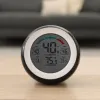Winter is here, and the air is dry.
You’ve already noticed the dryness, haven’t you? Maybe you’ve started using lip balm. Or maybe you’ve put on some wool socks, run across the living room carpet, and administered a static surprise to your significant other (or your kids). Whatever the case, it’s apparent that the air isn’t holding much humidity.
So, does that mean you need to install a humidifier in your home? If there was a simple answer to that question, we wouldn’t need to write this article. Yet here we are.
Whole-house humidifiers are common nowadays. They attach to your ductwork and blow moist air into your home, raising your relative humidity and, in theory, improving overall comfort.
But just as dehumidifiers aren’t always the best option for lowering humidity during summer, humidifiers aren’t always the best option for increasing humidity during winter. What’s more, humidifiers can cause just as many problems as they solve.
Wondering how to manage humidity in your Atlanta area home this winter? Whether a humidifier is the answer or not, our team can help!
With or without a humidifier, you might have comfort problems
Nobody installs a whole-house humidifier unless they’re having a problem of some kind. Many people absolutely can’t stand having dry skin during winter. It can be painful, and a humidifier probably will help your skin from getting too dry.
In other homes, the air gets so dry that wood furniture cracks and gaps form between floorboards. Pianos go out of tune. Everything just feels off-kilter (or off-key).
Super-low humidity just isn’t fun. Any time your indoor relative humidity dips into the middle-20% range, it’s a good idea to increase it. The thing is humidifiers have problems of their own:
- They might cause mold to grow in your home. This happens more often than you might think. Since humidity sticks to cold surfaces and your home contain many cold surfaces during winter, the environment is often perfect for fuzzy, black stuff to show up.
- You might not see the mold. While humidifier-induced mold sometimes clings to ceilings and walls, the mold that results from your humidifier isn’t always visible. It might be inside your walls or – and this is pretty common – lining the inside of your ducts. The “moldy ducts” scenario is more likely if you have uninsulated ducts, or a lot of your ductwork resides in an unconditioned area (like your attic). It’s cold in your attic, so moisture accumulates on the ducts when your humidifier is running. Then mold starts to grow there.
Mold, as you well know, can really do a number on indoor air quality. It’s bad to breathe it in. And if you’ve got asthma, a moldy environment can be dangerous.
The bottom line is that you don’t want to grow mold in your home, but you don’t want your air to be too dry either. What can you do to increase indoor humidity without increasing the risk of mold growth?
Air sealing keeps dry air out
How did the air in your home get so dry in the first place?
The answer is simple: Cold air from the outdoors infiltrated your home through gaps and cracks in the building envelope. Seal off the points of entry for that dry air, and you’ll increase your relative humidity.
If you do a good job, you won’t need a humidifier at all.
Think about it like this: Warm air migrates to colder environments. When you turn on the heat, the hot air generated by your furnace eventually seeps out of your home to the outdoors. To maintain a pressure balance inside a structure, the warm air that leaves your home is continuously replaced by cool air that gets in. This is air infiltration. It’s the draft you feel under your front door. It’s the cold air that seeps in around your windows.
Most of all, it’s the cold air that sneaks in through the plumbing, electrical, and ductwork penetrations between your first floor and your crawl space.
When you seal off these sources of air leakage, you achieve two things:
When you seal off these sources of air leakage, you achieve two things:
- You close off the “escape hatch” by which warm air leaves your home.
- You prevent air infiltration from the outdoors, which keeps your indoor humidity from getting too low.
Stated more simply, you should strongly consider air sealing your home before purchasing a whole-house humidifier. By doing so, you’ll be in a great position to mitigate uncomfortable dryness and avoid all of the problems associated with humidifiers.
The best way to discover your biggest sources of air leakage is via a blower door test. That way, you can determine both the air infiltration rate and identify the biggest sources of leakage.
If you do opt for a humidifier…
Air sealing should always be your first course of action to alleviate problems caused by dry indoor air. That said, there are circumstances when you might want a humidifier anyway. For example, maybe your household activities don’t generate enough humidity to make you comfortable, even after you’ve air sealed your home. You need a humidifier to even things out, so to speak.
Whatever your reasons for installing a whole-house humidifier, these best practices will help you avoid potential mold and indoor air quality issues:
- Get a steam humidifier: Steam humidifiers boil water on their own. Unlike bypass humidifiers, which “steal” a little hot air from your supply duct to generate water vapor, steam models are more efficient. You get more humidity during a shorter run time. Bypass models also dump hot air right back into your return plenum, which can increase the temperature of the incoming air and cause your system to overheat. A proper installation can mitigate this, but it’s still a risk.
- Only run the humidifier when the furnace is on: If your ducts are in an unconditioned space (most people’s ducts are), running the humidifier while the ducts are cold increases your risk of mold growth. By setting the humidifier to only run when the furnace is calling, you can be reasonably sure that the hot air is blowing the moisture out of your ducts and into your home.
Every home is different, so your humidifier installation might require a unique approach. Always work with an experienced HVAC contractor who uses sound installation methods and takes stringent quality control measures.
Another option: Add humidity without a whole-house humidifier
If you just want to increase your relative humidity a little bit and you’re looking for a cheap way to do so, consider a table humidifier. Just put it on your bedside table or a shelf, add water, and turn it on. Voila! You’ve increased your relative humidity.
To be sure, these are room-specific humidifiers. They won’t be sufficient for, say… keeping your living room furniture from cracking due to extreme dryness. But they will make you more comfortable while you’re sleeping or just hanging out with the family.
You might also try leaving the bath fans off when you take a shower. Leave the bathroom door cracked, too. That way, the steam from your shower will spread throughout your home.
In some cases, this small increase in relative humidity might be all you need to stay comfortable.
Another option: Trade your gas furnace for a dual fuel system
Your gas furnace blows hot air. And the hotter the air, the faster your heat loss.
If you have an open-combustion furnace inside the conditioned part of your home (like inside a closet), it removes air from your living space every time it kicks on. The result? More air infiltration from outdoors. If you’ve got a sealed-combustion furnace or your open-combustion furnace lives in your attic or crawl space (the non-conditioned part of your home) and you still have really dry air despite air sealing your home, it’s possible that the super-hot heat from your furnace just isn’t holding enough humidity and you’re not making up for it with activities like cooking, showering, and so on.
For these reasons, heating your home with something other than natural gas might help your family avoid some of the discomforts we all experience in dry conditions. Think less lotion, less lip balm, and no more scratchy throats in the mornings.
You just have to use less gas heat, less often. But how are you supposed to do that when your home is set up to use natural gas?
Enter dual fuel systems! If you’re already planning to replace your natural gas furnace sometime soon, consider switching to dual fuel. With a dual fuel system, you only heat your home with gas when you need to. The rest of the time, you heat your home with a heat pump. Here’s why it might be a good idea:
- Heat pumps blow “less hot” hot air: When it’s running, the air produced by a heat pump is warmer than the ambient temperature, but not as hot as the air produced by a gas furnace. As a result, you experience slower, less severe air infiltration.
- Here in Georgia, the gas won’t kick in until it gets really cold outside: In a dual fuel system, you’ll use your heat pump until the outdoor temperature drops to around 40 degrees. That’s pretty cold! Throughout the winter, you might only run your gas furnace around 50% of the time. You won’t have to deal with ultra-dry indoor misery nearly as often.
- Heat pumps are way more efficient than they used to be: If you’ve already got gas lines connected to your home, you may as well use them! That being said, switching to dual fuel is by no means a foolish choice. Today’s heat pumps are far more efficient than what was around 20 years ago. “Resistance heat” or “heat strips” aren’t quite a relic of the past, but newer systems don’t depend on them nearly as much as the old ones did. If you’re going the dual fuel route, you won’t have to worry about electric heat strips coming on.
You can also keep using an all-gas system, but upgrade to a two-stage or multi-stage gas valve furnace. That way, the blower won’t send so much hot air all at once, reducing rapid air infiltration and uncomfortable dryness. It won’t be as dramatic as what you get with dual fuel, but you’ll probably notice the difference.
For many homeowners in our climate zone, opting for dual fuel heat or upgrading a furnace are great ways to increase indoor comfort during winter. Combine efficient, high-performance heating equipment with a thorough air sealing job, and you’re set!
You might not need a whole-house humidifier at all – and that’s a good thing.






